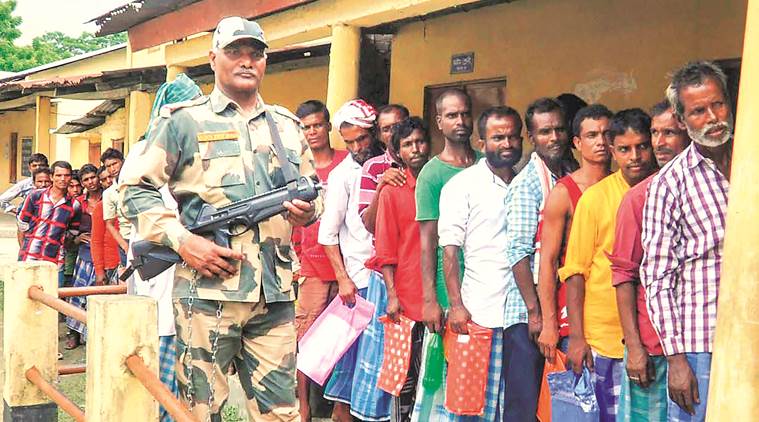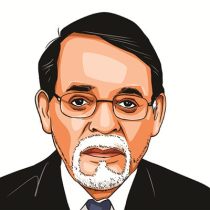For lakhs of immigrants, NRC puts final seal on citizenship. For others, it’s a long road to closure
National Register of Citizens: Beginnings and endings
For lakhs of immigrants, Muslim and Hindu, NRC puts final seal on citizenship. For others, it’s a long road to closure.

As per the 2011 language census, the number of Assamese speakers has decreased to 48 per cent from 58 per cent in 1991 while Bengali speakers have increased from 22 per cent (1991) to 30 per cent.
It’s been a week since the publication of the final draft of the National Register of Citizens. The prophets of doom have been proved wrong and a sense of calm prevails throughout the state. Not to speak of media and social analysts, even the state government which had asked for an additional 150 companies of para-military forces to deal with possible outbreaks of violence and had sought help from the Northeast Space Application Centre for proper mapping of the char or riverine areas for better policing, seems to have been caught by surprise.
Many have attributed this calm to the assurance given by the central government that mere omission of names from the NRC did not amount to being labelled a foreigner and that those left out of the NRC would be able to file claims before September 28 with a hint that this date could be further extended. Others have said that it goes to the credit of the Assamese and other indigenous people that they have reacted with “maturity” to the announcement that such a large number of “foreigners” have been detected in their state. Most of the Assamese nationalist organisations like the AASU and the AJYCP have declared that they would help all those Indian citizens whose names have not figured in the NRC to file their claims and have even offered to provide free legal assistance to those who cannot afford it.
This sudden sense of magnanimity on the part of the AASU and its sister organisations, who have enthusiastically celebrated the publication of the final draft list, seems to stem from the fact that they see the NRC as a final vindication of their several decades-long struggle to rid the state of foreign nationals. For them, this appears to be the beginning of a closure of an issue that has bogged the state since Independence. Whether it would really be a closure remains to be seen, especially because of the immense humanitarian dimensions involved in making lakhs of people stateless. But as of now, one notices a major change in the AASU’s usual rhetoric which appears quite toned down and accommodative, especially because it would like to take along with it all the stakeholders in the process, including minority organisations which it had long considered as enemies.
Now that doubts about the citizenship of lakhs of pre-1971 Muslim immigrants have been cleared, the AASU would obviously need their support to resist what is being seen by many as an onslaught on the status of the Assamese language by the rising number of Bengali speakers in the state. As per the 2011 language census, the number of Assamese speakers has decreased to 48 per cent from 58 per cent in 1991 while Bengali speakers have increased from 22 per cent (1991) to 30 per cent.
Although several minority organisations of Assam have expressed their doubts about the NRC process, the overall response to the publication of the NRC’s final draft has been quite positive. In most of the local TV shows, leaders of these organisations have welcomed the NRC and have expressed the hope that in the final list, the names of most of those who do not figure now would be included. It appears that the apprehensions that there would be a large-scale deletion of names in the Bengali-dominated areas of the Barak and Brahmaputra Valley have not been substantiated by the final NRC list.
According to a survey carried out by senior journalist Mrinal Talukdar of the leading local TV channel, Pratidin, the highest number of deletions, percentage wise, has been in the districts of Nagaon, Darrang, Bongaigaon and Kamrup Metro, where it ranges from 25 to 31 per cent, Darrang district heading the list. By contrast, the deletion figures are substantially less in districts like Morigaon, Karimganj, Goalpara, Barpeta, Cachar which have always been seen as dominated by illegal infiltrants from Bangladesh.
Another reason why the NRC figures have not created a stir is the fact that most of the pre-1971 immigrants of East Pakistan/ Bangladesh origin who have been living all these years with the tag of a foreigner have now found a place in the citizens’ register. The Deputy Speaker of the Assam assembly, Dilip Kumar Paul, summed up this feeling of relief when he said that despite his wife’s name not figuring in the list, he was happy that the people of Cachar and the Barak Valley, who have long carried the “Bangladeshi tag”, are now finally rid of it. The NRC, he said, has finally put the seal of citizenship on 90 per cent of the people of Barak Valley. This is also true of most of the other districts of the Brahmaputra and Barak Valleys where large masses of people long seen as illegal migrants from Bangladesh and looked upon with suspicion have now been cleared of stigma and accepted as citizens at par with the state’s indigenous people. This is certainly a great relief for these people and partly explains the lack of tension in the state following the publication of the NRC.
It needs to be seen that for lakhs of immigrants, both Muslim and Hindu, the NRC has put a final seal on their citizenship and this is a great closure for them. In this context, It is significant that organisations like the Assam Sanmilita Mahasangha, which has moved the Supreme Court for 1951 to be the cut-off year instead of 1971, have accused the AASU and the Asom Sahitya Sabha of betraying the Assamese cause by helping lakhs of “foreigners” to get citizenship.
It is near certain that after all the claims and objections are dealt with, the actual number of deletions will substantially come down. But even then, there would be a massive number of stateless persons, necessitating a well coordinated, nationwide move to work out a solution within humanitarian parameters. But that in itself should not deflect from the ground reality in Assam where immigration and demographic change continue to be a major concern for the indigenes.
Misra is author of The Burden of History: Assam and the Partition.
For all the latest Opinion News, download Indian Express App






































No hay comentarios:
Publicar un comentario